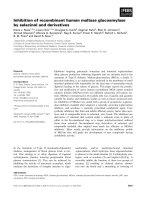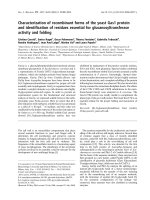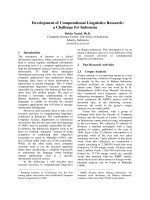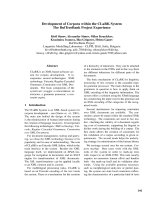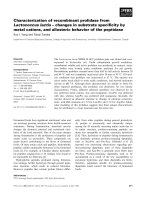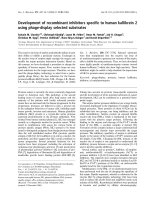Báo cáo khóa học: Development of recombinant inhibitors specific to human kallikrein 2 using phage-display selected substrates docx
Bạn đang xem bản rút gọn của tài liệu. Xem và tải ngay bản đầy đủ của tài liệu tại đây (182.25 KB, 7 trang )
Development of recombinant inhibitors specific to human kallikrein 2
using phage-display selected substrates
Sylvain M. Cloutier
1,2
, Christoph Ku¨ ndig
2
, Loyse M. Felber
1
, Omar M. Fattah
1
, Jair R. Chagas
3
,
Christian M. Gygi
1
, Patrice Jichlinski
1
, Hans-Ju¨ rg Leisinger
1
and David Deperthes
1,2
1
Urology Research Unit, Department of Urology, CHUV, Epalinges, Switzerland;
2
Med Discovery SA, Epalinges, Switzerland;
3
Centro Interdisciplinar de Investigacao Bioquimica, Universidade de Mogi das Cruzes, Brazil
The reactive site loop of serpins undoubtedly defines in part
their ability to inhibit a particular enzyme. Exchanges in
the reactive loop of serpins might reassign the targets and
modify the serpin–protease interaction kinetics. Based on
this concept, we have developed a procedure to change the
specificity of known serpins. First, reactive loops are very
good substrates for the target enzymes. Therefore, we have
used the phage-display technology to select from a penta-
peptide phage library the best substrates for the human
prostate kallikrein hK2 [Cloutier, S.M., Chagas, J.R., Mach,
J.P., Gygi, C.M., Leisinger, H.J. & Deperthes, D. (2002)
Eur. J. Biochem. 269, 2747–2754]. Selected substrates
were then transplanted into the reactive site loop of
a1-antichymotrypsin to generate new variants of this serpin,
able to inhibit the serine protease. Thus, we have developed
some highly specific a1-antichymotrypsin variants toward
human kallikrein 2 which also show high reactivity. These
inhibitors might be useful to help elucidate the importance
of hK2 in prostate cancer progression.
Keywords: phage-display; protease; human kallikrein;
inhibitor; a1-antichymotrypsin.
Prostate cancer is currently the most commonly diagnosed
cancer in American men. This pathology is the second
leading cause of cancer death after lung cancer and the
majority of the patients with locally advanced prostate
cancer have an increased risk for disease progression. In this
progression, proteases are believed to play a pivotal role
in the malignant behaviour of cancer cells, including rapid
tumor growth, invasion and metastasis. Human glandular
kallikrein (hK2) protein is a trypsin-like serine protease
expressed predominantly in the prostate epithelium. First
isolated from human seminal plasma [1], hK2 has emerged
recently as a diagnostic marker for prostate cancer. When
tested in combination with assays for various forms of
prostate specific antigen (PSA), hK2 seemed to be better
suited to distinguish malignant from benign prostate disease
than the well established marker PSA (prostate specific
antigen or hK3) [2–4]. In addition to its role as a marker, the
proteolytic activities suggest that hK2 could contribute to
cancer progression. Several potential functions for this
enzyme have been proposed, including the activation of
urokinase-type plasminogen activator [5] and inactivation
of plasminogen activator inhibitor-1 [6], activation of pro-
PSA [7], degradation of fibronectin [8] and degradation of
insulin-like growth factor binding protein (IGF-BP) [9].
Taking into account its prostate tissue-specific expression
and the involvement of all its potential substrates in cancer
development, hK2 can be considered as a potential thera-
peutic target.
Theserpins(serineproteaseinhibitors)arealargefamily
of proteins implicated in the regulation of complex physio-
logical processes. These proteins of about 45 kDa can be
subdivided into two groups, one being inhibitory and the
other noninhibitory. Serpins contain an exposed flexible
reactive-site loop (RSL), which is implicated in the inter-
action with the putative target protease. Following the
binding to the enzyme and cleavage of the P1-P’1 scissile
bond of the RSL, a covalent complex is formed [10].
Formation of this complex induces a major conformational
rearrangement and thereby traps irreversibly the target
protease. The inhibitory specificity of serpins is attributed
largely to the nature of the residues at P1-P¢1 positions and
the length of the RSL. Changing the RSL domain or the
reactive site of serpins is one approach to understand the
inhibitory process between a serpin and an enzyme [11–13]
and to develop specific inhibitors.
Several serpins, such as protein C inhibitor, a2-antiplas-
min, antithrombin-III, a1-antichymotrypsin (ACT), or
protease inhibitor 6 [8,14,15] have been identified as hK2
inhibitors. The relatively slow complex formation between
hK2 and ACT [14] is attributed mainly to residues Leu358-
Ser359 at P1-P¢1 positions of the RSL, an unfavourable
peptide bond for this trypsin-like enzyme.
Modifications of the RSL of a1-antichymotrypsin have
been performed with the aim of changing the specificity of
this serpin. Peptide sequences, selected as substrates for the
enzyme hK2 by phage-display technology [16], have been
used to replace the scissile bond and neighbour amino acid
residues of the RSL. Recombinant inhibitors were produced
in bacteria and purified by affinity chromatography.
Correspondence to D. Deperthes, Urology Research Unit, Biopoˆ le,
Ch. Croisettes 22, CH-1066 Epalinges, Switzerland.
Fax: + 41 21 6547133, Tel.: + 41 21 6547130,
E-mail:
Abbreviations:ACT,a1-antichymotrypsin; Chtr, chymotrypsin; HNE,
human neutrophil elastase; PK, plasma kallikrein; PSA, prostate
specific antigen; uPA, urokinase plasminogen activator.
(Received 7 November 2003, revised 5 December 2003,
accepted 12 December 2003)
Eur. J. Biochem. 271, 607–613 (2004) Ó FEBS 2004 doi:10.1111/j.1432-1033.2003.03963.x
Compared to wild-type rACT, which inhibited hK2 very
slowly (12–16 h), the modified rACTs formed a covalent
complex very quickly (within minutes). Three of the six rACT
variants were specific to hK2 with high association constants.
Materials and methods
Materials
hK2 and hK3 (PSA) were purified from human semen as
described previously [14,17]. Anti-hK2 and anti-PSA
monoclonal Igs were a gift from R. R Tremblay (Laval
University, Canada). Human chymotrypsin (Chtr), urokin-
ase plasminogen activator (uPA), human kallikrein hK1,
human plasma kallikrein (PK), human neutrophil elastase
(HNE) and commercial ACT (human plasma a1-antichy-
motrypsin) were purchased from Calbiochem. Z-Phe-Arg-
AMC, Suc-Ala-Ala-Pro-Phe-AMC, Z-Gly-Gly-Arg-AMC,
MeOSuc-Ala-Ala-Pro-Val-AMC were purchased from
Calbiochem. CFP-TFRSA-YFP fluorescent substrate was
developed as described previously [16,18]. The cDNA for
human a1-antichymotrypsin (ACT) was a generous gift
from H. Rubin (University of Pennsylvania).
Site-directed mutagenesis
Following the subcloning of ACT cDNA into pQE-9
expression vector (Qiagen, Germany) and the introduction
of a His
6
tagattheNterminalofrACT
WT
, two restriction
sites SacII and MluI, were incorporated 18 bp upstream
and 18 bp downstream of the P1 codon in RSL domain,
respectively. These sites were created by a silent mutation
using oligonucleotides 5¢-GTGATTTTGACCGCGGTGG
CAGCAG-3¢ for SacII and 5¢-GCACAATGGTACGCG
TCTCCACTAATG-3¢ for MluI site and following the
quickchange mutagenesis protocol supplied by Stratagene.
Construction and expression of recombinant wild-type
ACT and its variants
Six variants, which correspond to a change in the reactive
site loop in positions between P3 and P3¢ (Table 1), were
generated by PCR extension of the template oligonucleo-
tides: rACT
8.20
,5¢-TACCGCGGTCAAAATCACCCTCC
GTTCTCGAGCAGTGGAGACGCGTGA-3¢;rACT
6.3
,
5¢-TACCGCGGTCAAAATCACC
AGGAGGTCTATC
GATGTGGAGACGCGTGA-3¢;rACT
8.3
,5¢-TACCGCG
GTCAAAATC
AGGGGGAGATCTGAGTTAGTGGA
GACGCGTGA-3¢;rACT
6.7
,5¢-TACCGCGGTCAAAAT
C
AAGCTTAGAACAACATTAGTGGAGACCGCTG
A-3¢;rACT
6.1
,5¢-TACCGCGGTCAAAATCATGACAA
GATCTAACTTAGTGGAGACGCGTGA-3¢;rACT
5.18
,
5¢-TACCGCGGTCAAAATCACC
GAGCGTGTCTCG
CCCGTGGAGACGCGTGA-3¢ (where underlined sequ-
ences encode new cleavage sites in the reactive site loop),
using primers corresponding to the flanking regions:
5¢-TACCGCGGTCAAAATC-3¢ and 5¢-TCACGCGTGT
CCAC-3¢. PCR products were digested with SacII and
MluI restriction enzymes and then subcloned into digested
rACT
WT
construct. Recombinant serpins were produced in
TG1 Escherichia coli strain. Cells were grown at 37 °Cin
2· TYmedia(16gtryptone,10gyeastextract,5gNaCl
per L) containing 100 lgÆmL
)1
ampicillin to A
600
¼ 0.5.
Isopropyl thio-b-
D
-galactoside (IPTG) was then added to a
final concentration of 0.5 m
M
allowing the expression of
recombinant serpins for 16 h at 16 °C. The cells from
100 mL of culture were harvested by centrifugation, resus-
pended in cold NaCl/P
i
and then passed through a French
press to recover the total soluble cytoplasmic proteins. Cell
debris were removed by centrifugation and Ni
2+
-nitrilotri-
acetic affinity agarose beads were added to the supernatant
for 90 min at 4 °C to bind recombinant serpins. The resin
was washed subsequently with 50 m
M
Tris, pH 8.0, 500 m
M
NaCl, 25 m
M
imidazole and the bound proteins were eluted
for 10 min with 50 m
M
Tris, pH 8.0, 500 m
M
NaCl and
150 m
M
imidazole. Once purification was completed, rACT
were dialysed against 50 m
M
Tris, pH 8.0, 500 m
M
NaCl,
0.05% Triton X-100 for 16 h at 4 °C. The protein
concentration was determined for each purification by
Bradford assay and normalized by densitometry of Coo-
massie Blue-stained SDS/PAGE gels [19].
Inhibition assays and stoichiometry of inhibition
The stoichiometry of inhibition (SI) values were determined
for the inhibition of rACT
WT
and its variants with hK2 and
different other enzymes. An initial test was made with a
molar excess of rACT (100-fold) over hK2, PSA, hK1,
chymotrypsin (Chtr), plasma kallikrein (PK), urokinase
(uPA) and human neutrophile elastase (HNE) enzymes. The
Table 1. Alignment of RSL (reactive serpin loop) of recombinant serpin a1-antichymotrypsin (ACT) and its variants. Substrate peptides selected by
kallikrein hK2 using a phage-displayed random pentapeptide library (12). Plain type residues are common to rACT
WT
, bold residues correspond to
substrate peptides relocated in RSL of ACT variants. The scissile bond by hK2 in substrate peptides is designated by fl and putative cleavage site in
serpins is marked by asterisks between the P1-P1¢ residues.
Serpin
Selected
substrate peptide P6 P5 P4 P3 P2 P1 P¢1P¢2P¢3P¢4P¢5P¢6
rACT
WT
–VKITLL*SALVET
rACT
8.20
LRflSRA V K I T LR* SRAVET
rACT
6.2
RRflSID V K I T RR* SI DVET
rACT
8.3
RGRflSE V K I RGR* SELVET
rACT
6.7
KLRflTT V K I KLR* TTLVET
rACT
6.1
MTRflSN V K I MT R* SNLVET
ACT
5.18
ERflVSP V K I T ER* VS PVET
608 S. M. Cloutier et al. (Eur. J. Biochem. 271) Ó FEBS 2004
reaction was performed for 30 min at 25 °C(90minat
37 °C for PSA) in reaction buffer (50 m
M
Tris, pH 7.5,
150 m
M
NaCl, 0.05% Triton X-100, 0.01% BSA) and
residual enzyme activity was measured by adding fluorescent
substrates (Z-Phe-Arg-AMC for hK1, hK2 and PK, Suc-
Ala-Ala-Pro-Phe-AMC for Chtr, Z-Gly-Gly-Arg-AMC for
uPA, MeOSuc-Ala-Ala-Pro-Val-AMC for HNE, and CFP-
TFRSA-YFP for PSA). Activity of enzyme in presence
of inhibitors was compared to uninhibited reaction. For
reactions where an inhibition was observed, SI was deter-
mined by incubating different concentrations of recombin-
ant serpins. Using linear regression analysis of fractional
activity (velocity of inhibited enzyme reaction/velocity of
uninhibited enzyme reaction) vs. the molar ratio of the
inhibitor to enzyme ([I
o
]/[E
o
]), the stoichiometry of inhibi-
tion, corresponding to the abscissa intercept, was obtained.
Kinetics
The association rate constants for interactions of hK2,
chymotrypsin, PK and HNE with different rACTs were
determined under pseudo-first order conditions using the
progress curve method [20]. Under these conditions, a fixed
amount of enzyme (2 n
M
) was mixed with different
concentrations of inhibitor (0–800 n
M
) and an excess of
substrate (10 l
M
). Each reaction was made in reaction
buffer [50 m
M
Tris, pH 7.5, 150 m
M
NaCl, 0.05% (v/v)
Triton X-100, 0.01% (w/v) BSA] at 25 °C for 45 min and
the rate of product formation was measured using a FL
x
800
fluorescence 96-well microplate reader (Biotek, USA). In
this model, inhibition is considered to be irreversible over
the course of reaction and the progress of enzyme activity is
expressed by product formation (P), beginning at a rate (v
z
)
and is inhibited over time (t) at a first-order rate (k
obs
), rate
constant that is dependent only on inhibitor concentration.
P ¼ðv
z
=k
obs
Þ½1 À eðÀk
obst
Þ ð1Þ
For each inhibitor, a k
obs
was calculated for four different
concentrations of inhibitors via a nonlinear regression of
the data using Eqn 1. By plotting the k
obs
vs. inhibitor
concentration [I], a second-order rate constant, k¢, equal to
the slope of the curve (k¢ ¼ Dk
obs
/D[I]), was determined.
Due to the competition between inhibitor and the substrate,
Eqn 2 below is used to correct the second-order rate constant
k¢ by taking into account the substrate concentration [S] and
the K
m
of the enzyme for its substrate, giving the k
a
.
k
a
¼ð1 þ½S=K
m
ÞÂk
0
ð2Þ
The K
m
of hK2 for Z-FR-AMC, chymotrypsin for Suc-
AAPF-AMC, PK for Z-FR-AMC and HNE for MeOSuc-
AAPV-AMC were 67 l
M
, 145 l
M
, 170 l
M
and 130 l
M
,
respectively.
Western blot analysis of complex formation
and inhibitor degradation
Kallikrein hK2 was incubated 3 h at 37 °C with different
recombinant ACTs at a [I]
o
/[E]
o
ratio of 100 : 1 in 50 m
M
Tris, 200 m
M
NaCl, 0.05% (v/v) Triton X-100. Protein
samples were heated at 95 °C for 5 min, separated by SDS/
PAGE [12% (v/v) acrylamide, 19 : 1; T/C ratio) and then
electroblotted onto Hybond-ECL (Amersham Pharmacia)
nitrocellulose. The free-hK2 and hK2-ACT complexes were
detected using a mouse anti-hK2 monoclonal Ig and an
alkaline phosphatase-conjugated goat anti-mouse secon-
dary Ig. Western blot was visualized using the ECL
detection kit (Amersham Pharmacia Biotech). hK2 was
also incubated with ACT
8.3
or ACT
6.7
30 min at 25 °C
(kinetic conditions) at a [I]
o
/[E]
o
ratioof10:1in50m
M
Tris, 200 m
M
NaCl, 0.05% Triton X-100. Proteins were
detected by Western blot, using an anti-His
6
monoclonal Ig
followed by detection with the secondary antibody and
protocol described above.
Results
Production of soluble recombinant wild-type
and variant ACTs
Wild-type serpin a1-antichymotrypsin was used to develop
specific inhibitors of the kallikrein hK2. Residues P3-P3¢
located in the RSL structure of rACT
WT
were replaced
by substrate pentapeptides previously selected by phage-
display technology [16]. Six variants of rACT have been
designed and constructed (Table 1). The scissile bond in
substrate peptides was aligned according to Leu358-Ser359
into RSL of the serpin. rACT
WT
and its variants were
expressed in E. coli TG1 as fusion proteins containing a His
tag in the N-terminal position. Each of them was produced
at low temperature allowing protein accumulation, mainly
as the active soluble form. Purified under native conditions,
the level of production varied between 1.0 and 2.5 mgÆL
)1
.
The purity of serpins was estimated by SDS/PAGE analysis
and was more than 98% (Fig. 1).
rACT variants are specific mainly to kallikrein hK2
A panel of enzymes including human neutrophil elastase,
chymotrypsin-like (Chtr, PSA) and trypsin-like (hK2, hK1,
PK, uPA) proteases have been screened to determine
inhibitory specificity of rACT variants (Table 2). Incubating
with an excess of inhibitors ([I]
o
/[E]
o
of 100 : 1) for 30 min,
hK2 is completely inhibited by rACT
6.2
,rACT
8.3
,rACT
6.7
and rACT
6.1
,whereasrACT
8.20
and rACT
5.18
inhibited
95% and 73% of enzyme activity, respectively. Under these
Fig. 1. SDS/PAGE analysis of purified recombinant ACT under redu-
cing conditions. Variant 6.1 (lane 1) and wild-type ACT (lane2).
Ó FEBS 2004 Human kallikrein 2 inhibitors (Eur. J. Biochem. 271) 609
conditions, wild-type rACT showed no inhibitory activity
toward hK2. Among these variants, two are specific to hK2
(rACT
8.3
and rACT
5.18
), inhibiting no other tested enzyme.
Two other variants, rACT
6.7
and rACT
6.2
, also inhibited
PK at 36% and 100%, respectively. As with wild-type ACT,
variant rACT
8.20
inhibited the two chymptrypsin-like pro-
teases Chtr and PSA but additionally also PK and HNE.
None of the recombinant serpins showed inhibitory activity
against the kallikrein hK1 and uPA.
Stoichiometries of inhibition for variant ACTs for
hK2 are improved in comparison to wild-type ACT
The determination of the stoichiometry of inhibition was
accomplished under physiological conditions of pH and
ionic strength for all enzymes to ensure the most valuable
comparison. Recombinant wild-type ACT gave an SI value
of 2 (Table 3) with chymotrypsin, which is identical to the
value obtained with commercial ACT under similar condi-
tions (data not shown). All newly constructed variants of
ACT showed lower SI values with hK2 than wild-type ACT
(Fig. 2). From these variants, rACT6.7, rACT 6.1 and
rACT6.2 had the lowest stoichiometry of inhibition values
for hK2 (9, 19 and 25, respectively). Whereas rACT6.2 and
rACT6.1 also had the lowest SI values (18 and 16) for PK,
the SI for rACT6.7 was much higher (277). The two
recombinant ACTs specific for hK2, rACT8.3 and
rACT5.18 had higher SI ratios of 34 and 139, respectively.
The SI value of rACT8.20 inhibitor was superior to 100 for
all tested proteases including hK2.
Variant ACTs form stable complexes with hK2 without
degradation of inhibitors
Western blot analysis of the reaction products of rACTs
with hK2 was performed to determine the fate of inhibitors
after the interaction with the enzyme. Figure 3A shows that
when hK2 is incubated with ACT variants, free hK2 (E)
disappeared completely to form a covalent complex (E-I).
This covalent complex demonstrated high stability; no
breakdown over a 16 h incubation period (data not shown).
Wild-type ACT inhibited hK2 more slowly, which was
mainly uncomplexed after 3 h of incubation. Elevated SI
values measured with hK2 were not due to noncomplex
forming degradation of ACT variant inhibitors. rACT
6.7
with the lowest SI for hK2 of all ACT variants and the
highly hK2 specific variant rACT
8.3
were complexed with
hK2 and analyzed by Western blotting (Fig. 3B). All
inhibitor proteins were either complexed with hK2 or
present in the uncleaved form, indicating that the possible
substrate pathway for the serpin–enzyme interaction is
marginal [21].
Table 2. Inhibitory profile of rACT
WT
and its variants. The scissile bond by hK2 in substrate peptides is designated by fl. Amino acid sequence
cleaved in RSL (reactive serpin loop) of recombinant ACTs corresponding to selected substrate peptide by hK2. Protease and serpins were
incubatedfor30minat25°C(90minat37° for PSA) at an [I]
o
/[E]
o
ratio of 100 : 1. Percentage inhibiton corresponds to 100 · [1 – (velocity in
presence of inhibitor/velocity of unhibited control)].
Protease
Inhibition percentage
ACT
8.20
(LRflSRA)
ACT
6.2
(RRflSID)
ACT
8.3
(RGRflSE)
ACT
6.7
(KLRflTT)
ACT
6.1
(MTRflSN)
ACT
5.18
(ERflVSP)
ACT
WT
(LLflSA)
hK2 95 100 100 100 100 73 0
Chtr 66 0 0 0 0 0 100
PK 54 100 0 36 100 0 0
HNE 30 0 0 0 60 0 15
PSA 45 0 0 0 0 0 80
hK1 0 0 0 0 0 0 0
Urokinase 0 0 0 0 0 0 0
Table 3. Comparison of stoichiometry of inhibition values and second-order rate constants (k
a
) for the reaction of rACT
WT
and its variants with hK2
and others proteases. SI values reported were determined using linear regression analysis to extrapolate the I/E ratio (see Fig. 1). Second-order rate
constants for serpin–protease reactions were measured under pseudo first- or second-order conditions as described in Materials and methods.
Parentheses, amino acid sequence of P3-P3¢ residues in RSL (reactive serpin loop) of recombinant ACT corresponding to selected substrate peptide
by hK2; –, No detectable inhibitory activity, k
a
is measured in
M
)1
Æs
)1
.
Protease
ACT
8.20
(LRflSRA)
ACT
6.2
(RRflSID)
ACT
8.3
(RGRflSE)
ACT
6.7
(KLRflTT)
ACT
6.1
(MTRflSN)
ACT
5.18
(ERflVSP)
ACT
WT
(LLflSA)
SI k
a
SI k
a
SI k
a
SI k
a
SI k
a
SI k
a
SI k
a
hK2 105 1779 25 6261 34 2439 9 8991 19 3442 139 595 – –
Chtr 134 905 – – – – – – – – – – 2 61295
PK 150 424 18 6217 – – 277 201 16 8024 – – – –
HNE 334 158 – – – – – – 159 1192 – – – –
610 S. M. Cloutier et al. (Eur. J. Biochem. 271) Ó FEBS 2004
Variant ACTs showed highest association constants
with hK2
The rate of the inhibitory reaction with variant ACTs was
determined for each protease showing reactivity with these
inhibitors. After determination of k
obs
(Fig. 4), association
constants (k
a
) were calculated using the K
m
of the proteases
for their corresponding substrates (Table 3). The k
a
value
of wild-type ACT with chymotrypsin was identical to the
previously published k
a
[22]. The recombinant rACT
6.7
showed the highest k
a
(8991
M
)1
Æs
)1
) with hK2 whereas
that obtained with PK was 45-fold less. In contrast,
recombinant rACT
6.2
gave an equivalent k
a
with hK2 and
PK, demonstrating a lack of discrimination between the
two proteases. k
a
Values of hK2 specific recombinant
inhibitors rACT
8.3
and rACT
5.18
were lower (2439 and
595
M
)1
Æs
)1
, respectively,) whereas nonspecific ACT
8.20
exhibited a k
a
of 1779
M
)1
Æs
)1
, for hK2, superior compared
to Chtr, PK and HNE. One of the recombinant serpins,
rACT
6.1
, possessed a higher velocity with PK than with
hK2.
Discussion
The major challenge in the development of hK2 inhibitors is
the design of highly selective, potent and bioavailable
compounds that could be used for in vivo investigations. We
have previously used substrate phage-display to identify
peptide sequences that are efficiently and selectively cleaved
by hK2 [16]. The current study proposes the use of peptide
substrates selected by phage-display technology to change
the specificity of serpin ACT which is known to inhibit a
large panel of human enzymes such as chymotrypsin, mast
cell chymase [23], cathepsin G [24], prostatic kallikreins hK2
[14] and PSA [25].
Production of ACT in a bacterial recombinant system has
already been published by several groups and allows the
production of active inhibitors in soluble form [26]. In the
present work, reduction of temperature during induction to
16 °C allowed the production of fully intact ACTs purified
in one step by affinity chromatography. The efficiency of the
bacterial recombinant system to produce active ACT was
proved by the stoichiometry of inhibition of recombinant
wild-type ACT with chymotrypsin and its constant of
association which were similar to those obtained with
natural ACT [13]. All variants gave a production yield of
around 2 mgÆL
)1
of culture. We conclude that the bacterial
system is capable of a suitable-level of production of
functionally and structurally intact ACT variants.
Serpins trap their target proteases in the form of an acyl–
enzyme complex. However, the trap is kinetically controlled,
and the serpin–protease complexes can, in some cases,
ultimately break down, releasing a cleaved inactive serpin
and an active protease [10]. ACT can also have substrate
behaviour for some proteases. For example, Cathepsin
D [27] and Pseudomonas human elastase [28] hydrolyse the
RSL loop of ACT without formation of a covalent
complex. Thus, swapping of the amino acid sequences of
the reactive site loop does not guarantee maintenance of
Fig. 2. Stoichiometry of inhibition (SI) of hk2 by rACT
WT
and its
variants. hK2 (5 n
M
) was incubated with different concentrations
(6.25–500 n
M
)ofrACT
8.20
(·), rACT
6.2
(h), rACT
8.3
(n), rACT
6.7
(e), rACT
6.1
( ), rACT
5.18
(s), rACT
WT
(+), at 25 °Cfor30minin
reaction buffer. Residual activities (velocity) for hK2, were assayed by
adding the fluorescent substrate (10 l
M
) Z-FR-AMC. Fractional
velocity corresponds to the ratio of the velocity of inhibited enzyme (v
i
)
to the velocity of the uninhibited control (v
o
). The SI was determined
using linear regression analysis to extrapolate the I/E ratio (i.e. the
x intercept).
Fig. 3. Formation of complex between hK2 and recombinant inhibitors.
(A) hK2 was incubated 3 h at 37 °CwithrACT
8.20
(lane 1), rACT
6.2
(lane 2), rACT
8.3
(lane 3), rACT
6.7
(lane 4), rACT
6.1
(lane 5), rACT
5.18
(lane 6) and wild-type rACT (lane 7), at an I/E ratio of 100 : 1. The
complex formation was analyzed by Western blot under reducing
conditions using a mouse anti-hK2 Ig. (B) ACT
8.3
(lane 1) or ACT
6.7
(lane 3) were incubated with hK2 (lane 2 and 4, respectively) under
kinetic conditions (30 min at 25 °C) at an I/E ratio of 10 : 1. The
complex formation was analyzed by Western blot under reducing
conditions using a mouse monoclonal anti-His tag. Arrows indicate
hK2 (E), inhibitor (I), and hK2–ACT complex (E-I).
Ó FEBS 2004 Human kallikrein 2 inhibitors (Eur. J. Biochem. 271) 611
inhibitory activity of a serpin, which could be turned into
substrate. All variants developed from hK2 selected sub-
strates [16] form a stable covalent complex and are not
converted into substrate. The maintenance of the cleavage
axis in modified serpins is probably one of the essential rules
to respect to keep the inhibitory activity. Plotnick et al.[13]
reported that relocation of the RSL changes the complex
stability, which can lead to a complete loss of inhibitory
activity or inversely to an increase of inhibitory potential.
A SI value superior to one is generally interpreted as a
substrate with the behaviour of serpin. In this scheme, after
formation of an initial Michaelis complex and cleavage in
the reactive site loop, most of the complex is broken down
into active enzyme and the cleaved inhibitor, which is
inactivated. We analyzed ACT-hK2 reactions for noncom-
plex forming cleavage of the inhibitor, incubating the
samples at a 10 : 1 excess of inhibitor to protease. These
conditions, where SI values are close to or below those
calculated for the tested ACT variants (Table 3), normally
favour proteolysis of serpins or serpin–protease complexes.
Surprisingly, we observe a discrepancy to this hypothesis as
degradation of variant ACTs by hK2 was not observed
despite high SI values. A possible explanation for the lack of
ACT degradation is the condition under which the SI
determination was performed. Covalent ACT–hK2 com-
plexes form very slowly in vitro [14]. This is in agreement
with our observation that after 30 min of incubation at
25 °C, no inhibition of hK2 with wild-type ACT can be
detected (Table 2) and that even after prolonged incubation
at 37 °C hK2 is only partially complexed with wild-type
ACT (Fig. 3).
In this study, we have also assessed the specificity of new
inhibitors toward other proteases. The evaluation was
performed under the same conditions for all proteases
(pseudo-physiological conditions) in order to ensure a better
translation for further in vivo applications. The permuta-
tions of RSL cleavage site for hK2 phage-display selected
substrates changed wild-type ACT into highly sensitive
inhibitors for hK2. In addition, two of these inhibitors
showed a unique reactivity with hK2 and not with other
studied enzymes known to target similar biological sub-
strates, such as plasma kallikrein, hK1, PSA, urokinase, and
elastase. To our knowledge, this is the first report detailing
the development of a specific inhibitor for hK2. The fact
that four variants of ACT also inhibited plasma kallikrein
to some degree is not surprising taking into account their
homology of substrate specificity. Plasma kallikrein and
kallikrein hK2, are trypsin-like serine proteases and show
kininogenase activity [29]. However, variants of ACT are
more sensitive to hK2 than to plasma kallikrein, except
rACT
6.1
, which is the best inhibitor of PK. This data could
be explained by previous experiments designed to evaluate
the specificity of plasma kallikrein, which demonstrated that
specific elements are important for interaction with its active
site and notably hydrophobic amino acids in P¢2 [30]),
whereas, hK2 is more associated with small and noncharged
amino acids in this position [16,31]. Interestingly, besides
hK2 rACT
8.20
also inhibits chymotrypsin, and more weakly,
plasma kallikrein and human elastase. This large spectrum
of specificity is probably due to the presence of arginine,
leucine and alanine residues that are known to be suitable
for trypsin-like enzymes, chymotrypsin-like enzymes and
elastase, respectively.
We have developed different variants of ACT some of
which selectively inhibit human kallikrein hK2. The main
advantage of protein inhibitors such as serpins over small
chemical inhibitors is their high molecular mass and a long
half-life. In addition, as serpins are natural proteins present
in the blood circulation, they are expected to be less toxic
than chemical compounds. These novel inhibitors of hK2
will be useful for further experiments which would allow a
better understanding of the role of hK2 in prostate cancer
progression. In vivo evaluation of these inhibitors will permit
an evaluation of their potential as prostate cancer treat-
ments with xenografted animal models and indicate if
human kallikrein hK2 is a promising therapeutic target.
Acknowledgements
This work is supported by a grant from OPO Foundation (Zurich,
Switzerland).
Fig. 4. Inhibition of hK2 by rACT
WT
and its variants under pseudo-first
order conditions. The interaction of hK2 and recombinant serpins was
measured under pseudo first-order conditions using the progress curve
method. hK2 (2 n
M
) and substrate Z-FR-AMC (10 l
M
)wereaddedto
varying amounts (20–800 n
M
) of inhibitors (A) rACT
8.20
(e),
rACT
5.18
(+). (B) rACT
6.2
(s), rACT
8.3
(h), rACT
6.7
(n), rACT
6.1
(·). Representative progress curves were subjected to nonlinear
regression analysis using Eqn (1) and the rate (k
obs
) was plotted against
the serpin concentrations. A second-order rate constant (k¢)was
obtained from the slope of this line. Using Eqn (2) and K
m
of the
enzyme for this substrate (K
m
¼ 67 l
M
), a corrected second-order rate
constant was calculated (Table 3).
612 S. M. Cloutier et al. (Eur. J. Biochem. 271) Ó FEBS 2004
References
1. Deperthes, D., Chapdelaine, P., Tremblay, R.R., Brunet, C.,
Berton, J., Hebert, J., Lazure, C. & Dube, J.Y. (1995) Isolation of
prostatic kallikrein hK2, also known as hGK-1, in human seminal
plasma. Biochim. Biophys. Acta 1245, 311–316.
2. Tremblay,R.R.,Deperthes,D.,Tetu,B.&Dube,J.Y.(1997)
Immunohistochemical study suggesting a complementary role of
kallikreins hK2 and hK3 (prostate-specific antigen) in the func-
tional analysis of human prostate tumors. Am. J. Pathol. 150,455–
459.
3. Darson, M.F., Pacelli, A., Roche, P., Rittenhouse, H.G., Wolfert,
R.L., Young, C.Y., Klee, G.G., Tindall, D.J. & Bostwick, D.G.
(1997) Human glandular kallikrein 2 (hK2) expression in prostatic
intraepithelial neoplasia and adenocarcinoma: a novel prostate
cancer marker. Urology 49, 857–862.
4. Darson, M.F., Pacelli, A., Roche, P., Rittenhouse, H.G., Wolfert,
R.L., Saeid, M.S., Young, C.Y., Klee, G.G., Tindall, D.J. &
Bostwick, D.G. (1999) Human glandular kallikrein 2 expression in
prostate adenocarcinoma and lymph node metastases. Urology 53,
939–944.
5. Frenette,G.,Tremblay,R.R.,Lazure,C.&Dube,J.Y.(1997)
Prostatic kallikrein hK2, but not prostate-specific antigen (hK3),
activates single-chain urokinase-type plasminogen activator. Int. J.
Cancer 71, 897–899.
6. Mikolajczyk, S.D., Millar, L.S., Kumar, A. & Saedi, M.S. (1999)
Prostatic human kallikrein 2 inactivates and complexes with
plasminogen activator inhibitor-1. Int. J. Cancer 81, 438–442.
7. Takayama, T.K., Fujikawa, K. & Davie, E.W. (1997) Char-
acterization of the precursor of prostate-specific antigen. Activa-
tion by trypsin and by human glandular kallikrein. J. Biol. Chem.
272, 21582–21588.
8. Deperthes, D., Frenette, G., Brillard-Bourdet, M., Bourgeois, L.,
Gauthier, F., Tremblay, R.R. & Dube, J.Y. (1996) Potential
involvement of kallikrein hK2 in the hydrolysis of the human
seminal vesicle proteins after ejaculation. J. Androl. 17, 659–665.
9. Rehault, S., Monget, P., Mazerbourg, S., Tremblay, R., Gutman,
N., Gauthier, F. & Moreau, T. (2001) Insulin-like growth factor
binding proteins (IGFBPs) as potential physiological substrates
for human kallikreins hK2 and hK3. Eur J. Biochem. 268, 2960–
2968.
10. Huntington, J.A., Read, R.J. & Carrell, R.W. (2000) Structure of a
serpin-protease complex shows inhibition by deformation. Nature
407, 923–926.
11. Dufour, E.K., Denault, J.B., Bissonnette, L., Hopkins, P.C.,
Lavigne, P. & Leduc, R. (2001) The contribution of arginine
residues within the P6–P1 region of alpha 1-antitrypsin to its
reaction with furin. J. Biol. Chem. 276, 38971–38979.
12. Luke, C., Schick, C., Tsu, C., Whisstock, J.C., Irving, J.A.,
Bromme,D.,Juliano,L.,Shi,G.P.,Chapman,H.A.&Silverman,
G.A. (2000) Simple modifications of the serpin reactive site loop
convert SCCA2 into a cysteine proteinase inhibitor: a critical role
for the P3¢ proline in facilitating RSL cleavage. Biochemistry 39,
7081–7091.
13. Plotnick, M.I., Rubin, H. & Schechter, N.M. (2002) The effects of
reactive site location on the inhibitory properties of the serpin
alpha (1)-antichymotrypsin. J. Biol. Chem. 277, 29927–29935.
14. Frenette, G., Deperthes, D., Tremblay, R.R., Lazure, C. & Dube,
J.Y. (1997) Purification of enzymatically active kallikrein hK2
from human seminal plasma. Biochim. Biophys. Acta 1334,
109–115.
15. Saedi, M.S., Zhu, Z., Marker, K., Liu, R.S., Carpenter, P.M.,
Rittenhouse, H. & Mikolajczyk, S.D. (2001) Human kallikrein 2
(hK2), but not prostate-specific antigen (PSA), rapidly complexes
with protease inhibitor 6 (PI-6) released from prostate carcinoma
cells. Int. J. Cancer 94, 558–563.
16. Cloutier, S.M., Chagas, J.R., Mach, J.P., Gygi, C.M., Leisinger,
H.J. & Deperthes, D. (2002) Substrate specificity of human kal-
likrein 2 (hK2) as determined by phage display technology. Eur. J.
Biochem. 269, 2747–2754.
17. Frenette, G., Gervais, Y., Tremblay, R.R. & Dube, J.Y. (1998)
Contamination of purified prostate-specific antigen preparations
by kallikrein hK2. J. Urol. 159, 1375–1378.
18. Mahajan, N.P., Harrison-Shostak, D.C., Michaux, J. &
Herman, B. (1999) Novel mutant green fluorescent protein pro-
tease substrates reveal the activation of specific caspases during
apoptosis. Chem. Biol. 6, 401–409.
19. Laemmli, U.K. (1970) Cleavage of structural proteins during the
assembly of the head of bacteriophage T4. Nature 227, 680–685.
20. Morrison, J.F. & Walsh, C.T. (1988) The behavior and signi-
ficance of slow-binding enzyme inhibitors. Adv. Enzymol. Relat.
Areas Mol. Biol. 61, 201–301.
21. Lawrence, D.A., Ginsburg, D., Day, D.E., Berkenpas, M.B.,
Verhamme, I.M., Kvassman, J.O. & Shore, J.D. (1995) Serpin-
protease complexes are trapped as stable acyl-enzyme inter-
mediates. J. Biol. Chem. 270, 25309–25312.
22. Cooley, J., Takayama, T.K., Shapiro, S.D., Schechter, N.M. &
Remold-O’Donnell, E. (2001) The serpin MNEI inhibits elastase-
like and chymotrypsin-like serine proteases through efficient
reactions at two active sites. Biochemistry 40, 15762–15770.
23. Schechter, N.M., Sprows, J.L., Schoenberger, O.L., Lazarus, G.S.,
Cooperman, B.S. & Rubin, H. (1989) Reaction of human skin
chymotrypsin-like proteinase chymase with plasma proteinase
inhibitors. J. Biol. Chem. 264, 21308–21315.
24. Duranton, J., Adam, C. & Bieth, J.G. (1998) Kinetic mechanism
of the inhibition of cathepsin G by alpha 1-antichymotrypsin and
alpha 1-proteinase inhibitor. Biochemistry 37, 11239–11245.
25. Christensson, A., Laurell, C.B. & Lilja, H. (1990) Enzymatic
activity of prostate-specific antigen and its reactions with
extracellular serine proteinase inhibitors. Eur. J. Biochem. 194,
755–763.
26. Rubin, H., Wang, Z.M., Nickbarg, E.B., McLarney, S., Naidoo,
N.,Schoenberger,O.L.,Johnson,J.L.&Cooperman,B.S.(1990)
Cloning, expression, purification, and biological activity of
recombinant native and variant human alpha 1-anti-
chymotrypsins. J. Biol. Chem. 265, 1199–1207.
27. Pimenta, D.C., Chen, V.C., Chao, J., Juliano, M.A. & Juliano, L.
(2000) Alpha1-antichymotrypsin and kallistatin hydrolysis by
human cathepsin D. J. Protein Chem. 19, 411–418.
28. Plotnick,M.I.,Schechter,N.M.,Wang,Z.M.,Liu,X.&Rubin,
H. (1997) Role of the P6–P3¢ region of the serpin reactive loop
in the formation and breakdown of the inhibitory complex.
Biochemistry 36, 14601–14608.
29. Deperthes, D., Marceau, F., Frenette, G., Lazure, C., Tremblay,
R.R. & Dube, J.Y. (1997) Human kallikrein hK2 has low kini-
nogenase activity while prostate-specific antigen (hK3) has none.
Biochim. Biophys. Acta 1343, 102–106.
30. Almeida, P.C., Chagas, J.R., Cezari, M.H., Juliano, M.A. &
Juliano, L. (2000) Hydrolysis by plasma kallikrein of fluorogenic
peptides derived from prorenin processing site. Biochim. Biophys.
Acta 1479, 83–90.
31. Bourgeois, L., Brillard-Bourdet, M., Deperthes, D., Juliano,
M.A.,Juliano,L.,Tremblay,R.R.,Dube,J.Y.&Gauthier,F.
(1997) Serpin-derived peptide substrates for investigating the
substrate specificity of human tissue kallikreins hK1 and hK2.
J. Biol. Chem. 272, 29590–29595.
Ó FEBS 2004 Human kallikrein 2 inhibitors (Eur. J. Biochem. 271) 613

